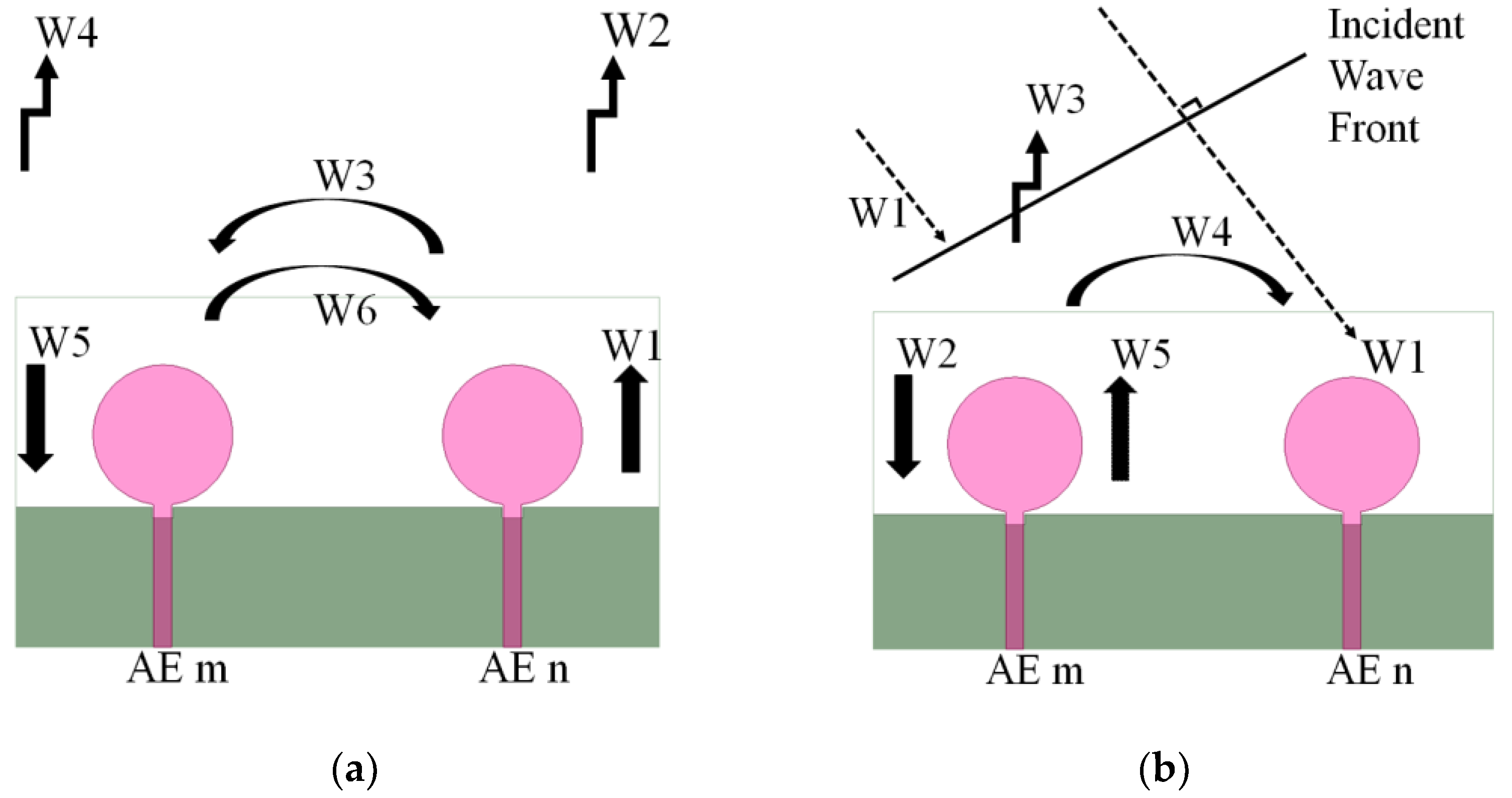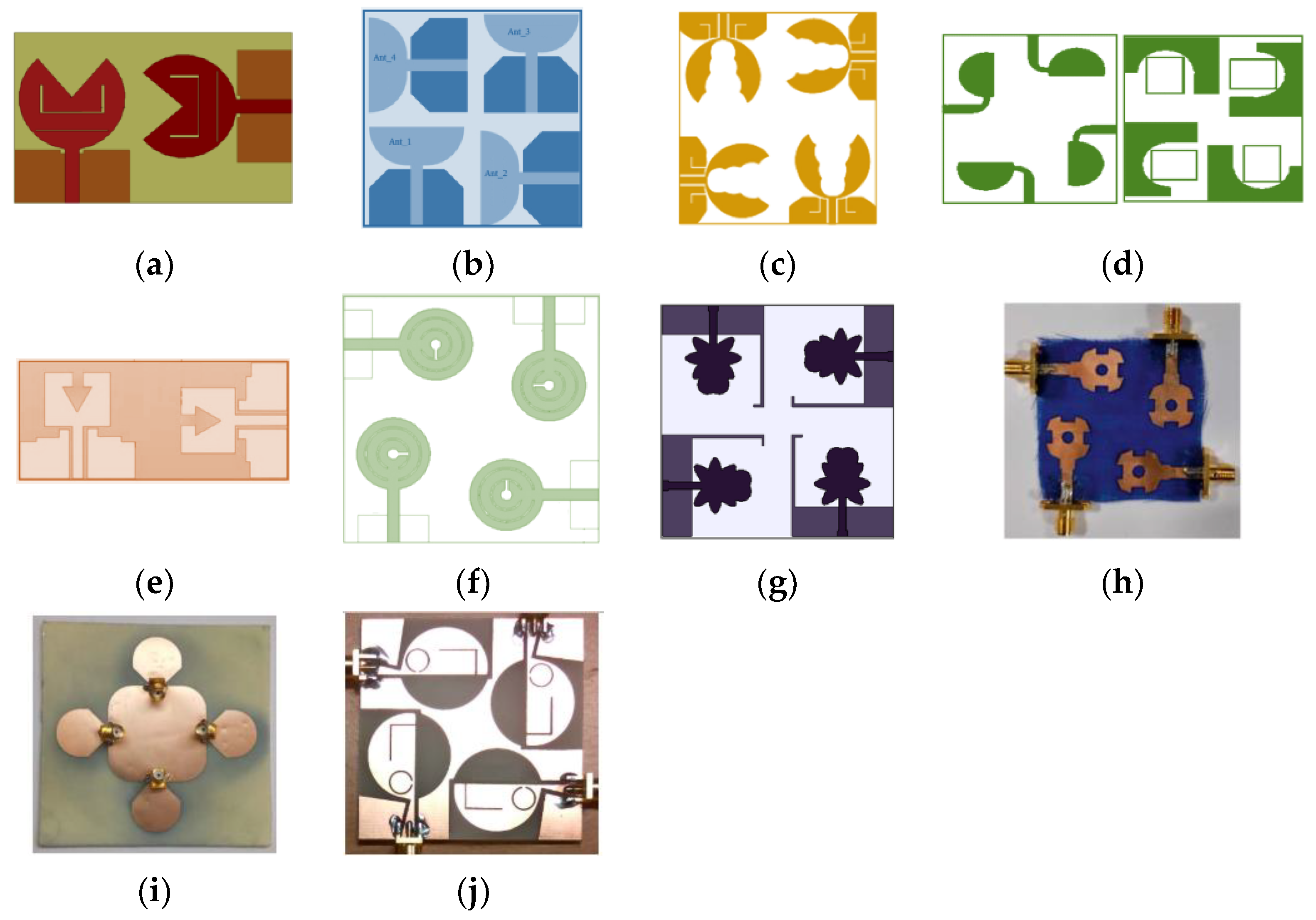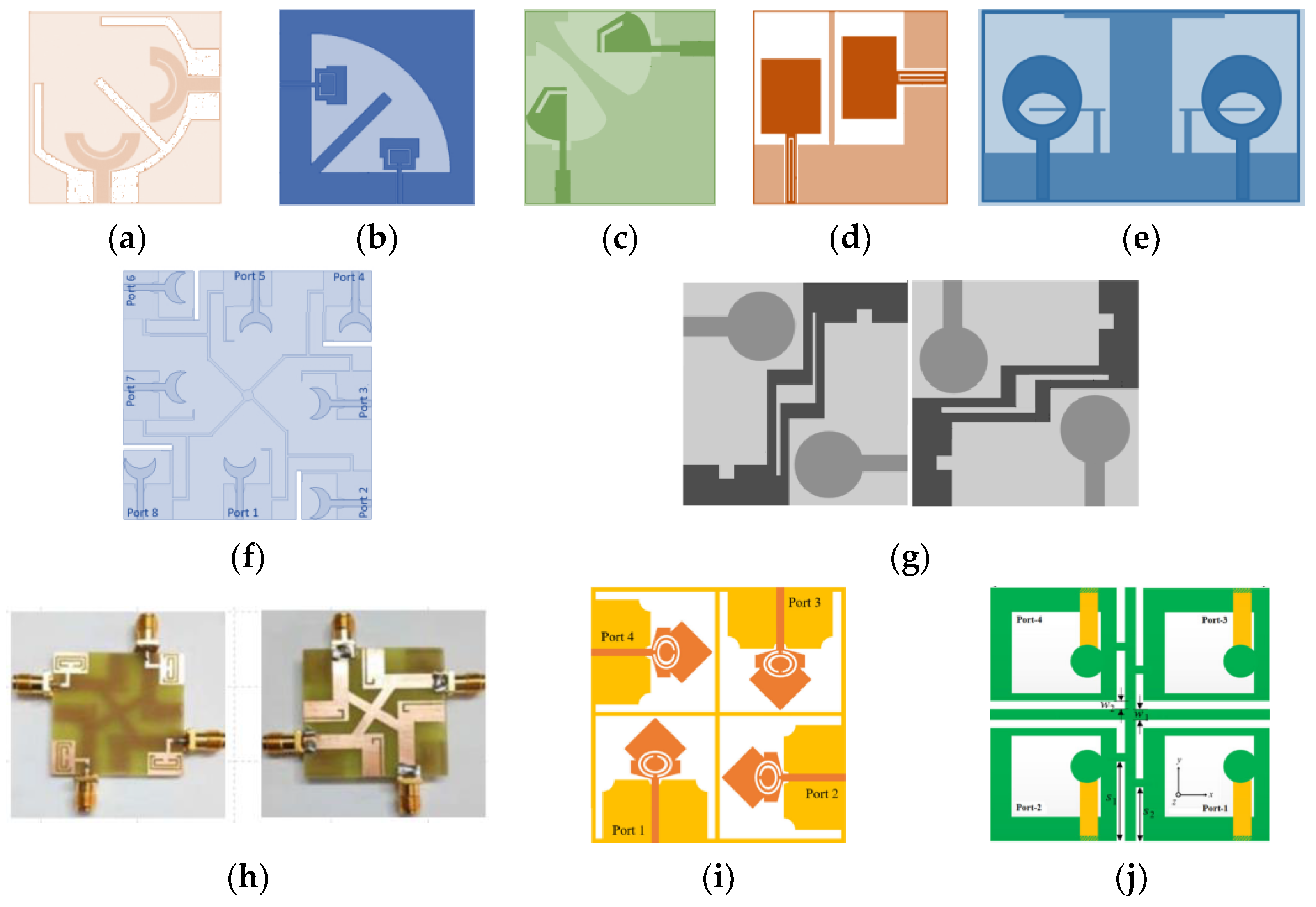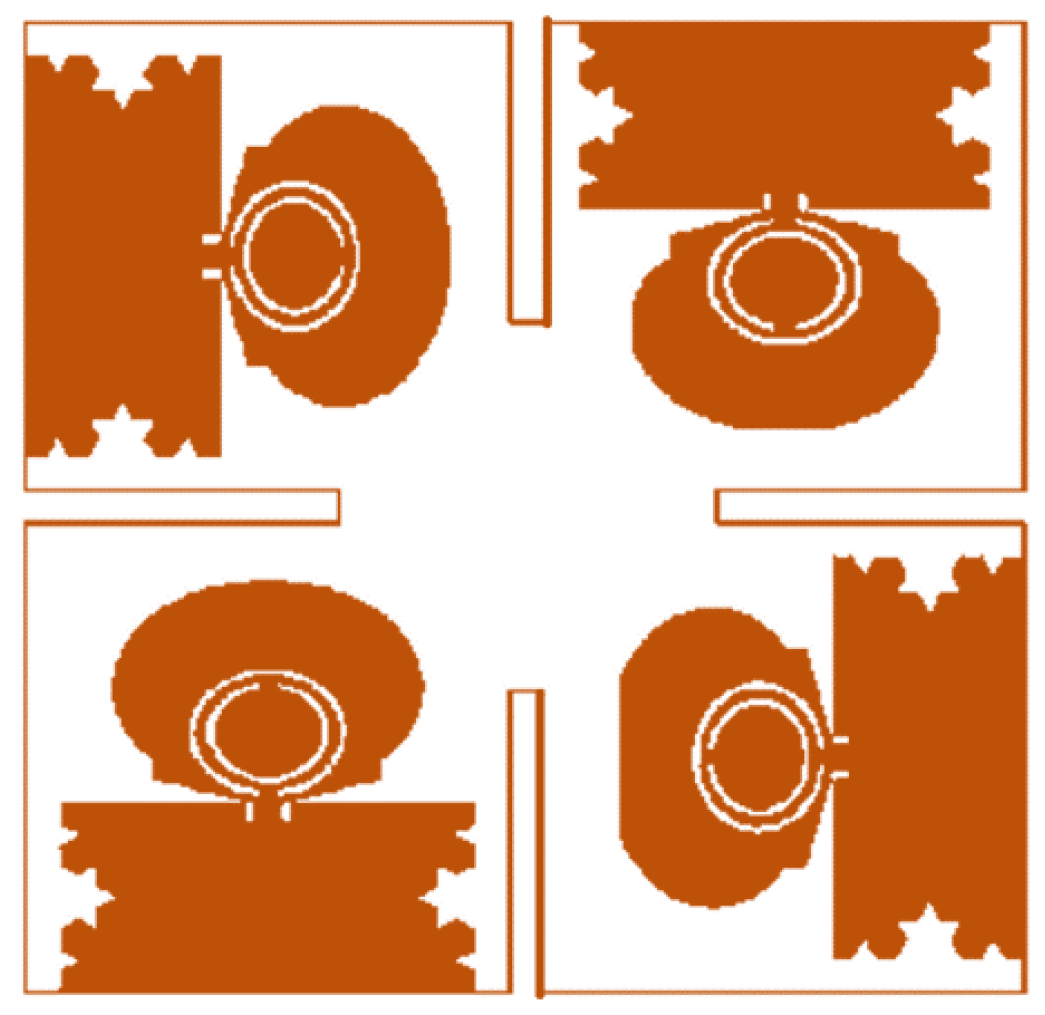Decoupling Methods in Planar Ultra-Wideband Multiple-Input-Multiple-Output Antennas: A Review of the Design, State-of-the-Art, and Research Challenges
Abstract
:1. Introduction
- In the proposed review article, all DTs for UMAs are analyzed in detail. This analysis will help the new researchers to understand all DTs.
- Various parameters of the reported UMAs are examined, such as antenna size, substrate used, isolation, bandwidth, and gain. This investigation provides shortcomings of the previously reported UMAs.
- A simulated study of all DTs has been carried out through the implementation of various types of DTs on the same two-port UMA, which consists of two microstrip-fed circular-shaped AEs with an open-end-slotted partial ground. This study determines the effect of applying various DTs on antenna parameters, such as impedance matching, isolation, and radiation pattern.
- A comparative analysis of various DTs has been carried out both with and without common ground (CG). Using this analysis, one can determine the best DT to obtain better isolation.
- This article can save time for the researchers to select appropriate DT without compromising the antenna performance.
2. Decoupling Techniques (DTs) in Ultra-Wideband MIMO Antennas (UMAs)
2.1. Placing AEs at 90 and 180
2.2. Decoupling Structure (DS)
2.3. Neutralization Line (NL)
2.4. Defected Ground Structure (DGS)
2.5. Metamaterial/Electromagnetic Band Gap (EBG) Structure
2.6. Parasitic Element
2.7. Carbon Black Film (CBF)
2.8. Slotted Edge Substrate (SES)
3. Simulated Study of Different Decoupling Techniques
3.1. Placing AEs at 90 and 180
3.2. Decoupling Structure (DS)
3.3. Neutralization Line (NL)
3.4. Defected Ground Structure (DGS)
3.5. Metamaterial
3.6. Parasitic Element (PE)
3.7. Carbon Black Film (CBF)
3.8. Slotted Edge Substrate (SES)
4. Conclusions
Author Contributions
Funding
Data Availability Statement
Acknowledgments
Conflicts of Interest
References
- Zhang, R.; Liang, Y.C.; Hall PS, P.; Gardner, P.; Kelly, J.; Ebrahimi, E. Federal Communications Commission Revision of Part 15 of the Commission’s Rules Regarding Ultra-Wideband Transmission System from 3.1 to 10.6 GHz; ET-Docket; Federal Communications Commission: Washington, DC, USA, 2002; pp. 98–153. [Google Scholar]
- Jiang, S.; Zhao, C.; Zhu, Y.; Wang, C.; Du, Y. A Practical and Economical Ultra-wideband Base Station Placement Approach for Indoor Autonomous Driving Systems. J. Adv. Transp. 2022, 2022, 3815306. [Google Scholar] [CrossRef]
- Saad, A.A.R.; Mohamed, H.A. Conceptual design of a compact four-element UWB MIMO slot antenna array. IET Microw. Antennas Propag. 2019, 13, 208–215. [Google Scholar] [CrossRef]
- Wilhite, T. Uses of Ultrawide Band Antennas. Turbo Future. 2 February 2021. Available online: https://turbofuture.com/industrial/Uses-of-Ultrawide-Band-Antennas (accessed on 1 March 2023).
- Zhu, F.; Gao, S.; Ho, A.T.; Abd-Alhameed, R.A.; See, C.H.; Brown, T.W.C.; Li, J.; Wei, G.; Xu, J. Multiple Band-Notched UWB Antenna with Band-Rejected Elements Integrated in the Feed Line. IEEE Trans. Antennas Propag. 2013, 61, 3952–3960. [Google Scholar] [CrossRef]
- Foschini, G.J. Layered space-time architecture for wireless communication in a fading environment when using multi-element antennas. Bell Labs Tech. J. 2002, 1, 41–59. [Google Scholar] [CrossRef]
- Paulraj, A.; Gore, D.; Nabar, R.; Bolcskei, H. An Overview of MIMO Communications—A Key to Gigabit Wireless. Proc. IEEE 2004, 92, 198–218. [Google Scholar] [CrossRef]
- Zhang, C.; Xiao, P.; Zhao, Z.-T.; Liu, Z.; Yu, J.; Hu, X.-Y.; Chu, H.-B.; Xu, J.-J.; Liu, M.-Y.; Zou, Q.; et al. A Wearable Localized Surface Plasmons Antenna Sensor for Communication and Sweat Sensing. IEEE Sens. J. 2023, 23, 11591–11599. [Google Scholar] [CrossRef]
- Yao, Y.; Shu, F.; Li, Z.; Cheng, X.; Wu, L. Secure Transmission Scheme Based on Joint Radar and Communication in Mobile Vehicular Networks. IEEE Trans. Intell. Transp. Syst. 2023, 24, 10027–10037. [Google Scholar] [CrossRef]
- Lin, Z.; Lin, M.; Champagne, B.; Zhu, W.-P.; Al-Dhahir, N. Secrecy-Energy Efficient Hybrid Beamforming for Satellite-Terrestrial Integrated Networks. IEEE Trans. Commun. 2021, 69, 6345–6360. [Google Scholar] [CrossRef]
- Lin, Z.; Niu, H.; An, K.; Wang, Y.; Zheng, G.; Chatzinotas, S.; Hu, Y. Refracting RIS-Aided Hybrid Satellite-Terrestrial Relay Networks: Joint Beamforming Design and Optimization. IEEE Trans. Aerosp. Electron. Syst. 2022, 58, 3717–3724. [Google Scholar] [CrossRef]
- Lin, Z.; An, K.; Niu, H.; Hu, Y.; Chatzinotas, S.; Zheng, G.; Wang, J. SLNR-based Secure Energy Efficient Beamforming in Multibeam Satellite Systems. IEEE Trans. Aerosp. Electron. Syst. 2022, 59, 2085–2088. [Google Scholar] [CrossRef]
- An, K.; Lin, M.; Ouyang, J.; Zhu, W.P. Secure Transmission in Cognitive Satellite Terrestrial Networks. IEEE J. Sel. Areas Commun. 2016, 34, 3025–3037. [Google Scholar] [CrossRef]
- Li, A.; Masouros, C.; Vucetic, B.; Li, Y.; Swindlehurst, A.L. Interference Exploitation Precoding for Multi-Level Modulations: Closed-Form Solutions. IEEE Trans. Commun. 2020, 69, 291–308. [Google Scholar] [CrossRef]
- Pan, S.; Lin, M.; Xu, M.; Zhu, S.; Bian, L.A.; Li, G. A Low-Profile Programmable Beam Scanning Holographic Array Antenna without Phase Shifters. IEEE Internet Things J. 2021, 9, 8838–8851. [Google Scholar] [CrossRef]
- Li, B.; Zhang, M.; Rong, Y.; Han, Z. Transceiver Optimization for Wireless Powered Time-Division Duplex MU-MIMO Systems: Non-Robust and Robust Designs. IEEE Trans. Wirel. Commun. 2021, 21, 4594–4607. [Google Scholar] [CrossRef]
- Chen, Z.; Tang, J.; Zhang, X.Y.; So, D.K.C.; Jin, S.; Wong, K.-K. Hybrid Evolutionary-Based Sparse Channel Estimation for IRS-Assisted mmWave MIMO Systems. IEEE Trans. Wirel. Commun. 2021, 21, 1586–1601. [Google Scholar] [CrossRef]
- Li, A.; Masouros, C.; Swindlehurst, A.L.; Yu, W. 1-Bit Massive MIMO Transmission: Embracing Interference with Symbol-Level Precoding. IEEE Commun. Mag. 2021, 59, 121–127. [Google Scholar] [CrossRef]
- Feng, Y.; Zhang, B.; Liu, Y.; Niu, Z.; Fan, Y.; Chen, X. A D-Band Manifold Triplexer with High Isolation Utilizing Novel Waveguide Dual-Mode Filters. IEEE Trans. Terahertz Sci. Technol. 2022, 12, 678–681. [Google Scholar] [CrossRef]
- Liu, Y.; Xu, K.-D. Millimeter-Wave Bandpass Filters Using On-Chip Dual-Mode Resonators in 0.13-μm SiGe BiCMOS Technology. IEEE Trans. Microw. Theory Tech. 2023, 71, 3650–3660. [Google Scholar] [CrossRef]
- Xu, K.-D.; Liu, Y. Millimeter-Wave On-Chip Bandpass Filter Using Complementary-Broadside-Coupled Structure. IEEE Trans. Circuits Syst. II Express Briefs 2023, 70, 2829–2833. [Google Scholar] [CrossRef]
- Xu, K.-D.; Guo, Y.-J.; Liu, Y.; Deng, X.; Chen, Q.; Ma, Z. 60-GHz Compact Dual-Mode On-Chip Bandpass Filter Using GaAs Technology. IEEE Electron. Device Lett. 2021, 42, 1120–1123. [Google Scholar] [CrossRef]
- Dai, B.; Zhang, B.; Niu, Z.; Feng, Y.; Liu, Y.; Fan, Y. A Novel Ultrawideband Branch Waveguide Coupler with Low Amplitude Imbalance. IEEE Trans. Microw. Theory Tech. 2022, 70, 3838–3846. [Google Scholar] [CrossRef]
- Huang, X.; Zhou, L.; Xu, J.-X.; Zhang, X.Y.; Mao, J.-F. BCB-Based Thin-Film Ka-Band Quarter-Mode SIW Packaged Filters with Ultrawide Stopband and Independently Controlled TZs. IEEE Trans. Microw. Theory Tech. 2022, 70, 4389–4398. [Google Scholar] [CrossRef]
- Huang, X.-L.; Zhou, L.; Yuan, Y.; Qiu, L.-F.; Mao, J.-F. Quintuple-Mode W-Band Packaged Filter Based on a Modified Quarter-Mode Substrate-Integrated Waveguide Cavity. IEEE Trans. Compon. Packag. Manuf. Technol. 2019, 9, 2237–2247. [Google Scholar] [CrossRef]
- Allen, J.L.; Diamond, B.L. Mutual Coupling in Array Antennas; MIT Lincoln Laboratory: Lexington, MA, USA, 1966. [Google Scholar] [CrossRef]
- Ding, G.; Anselmi, N.; Xu, W.; Li, P.; Rocca, P. Interval-Bounded Optimal Power Pattern Synthesis of Array Antenna Excitations Robust to Mutual Coupling. IEEE Antennas Wirel. Propag. Lett. 2023, 1–5. [Google Scholar] [CrossRef]
- Chung, K.L.; Tian, H.; Wang, S.; Feng, B.; Lai, G. Miniaturization of microwave planar circuits using composite microstrip/coplanar-waveguide transmission lines. Alex. Eng. J. 2022, 61, 8933–8942. [Google Scholar] [CrossRef]
- Kaiser, T.; Zheng, F.; Dimitrov, E. An Overview of Ultra-Wide-Band Systems with MIMO. Proc. IEEE 2009, 97, 285–312. [Google Scholar] [CrossRef]
- Cherry, S. Edholm’s Law of Bandwidth. IEEE Spectr. 2004, 41, 58–60. [Google Scholar] [CrossRef]
- Saritha, V.; Chandrasekhar, C. A Study and Review on Frequency Band Notch Characteristics in Reconfgurable MIMO UWB Antennas. Wirel. Pers. Commun. 2021, 118, 2631–2661. [Google Scholar] [CrossRef]
- Jhunjhunwala, V.K.; Ali, T.; Kumar, P.; Kumar, P.; Kumar, P.; Shrivastava, S.; Bhagwat, A.A. Flexible UWB and MIMO Antennas for Wireless Body Area Network: A Review. Sensors 2022, 22, 9549. [Google Scholar] [CrossRef]
- Gnanaharan, I.; Anbazhagan, R. Review on the Design of the Isolation Techniques for UWB-MIMO Antennas. Adv. Electromagn. 2018, 7, 46–70. [Google Scholar] [CrossRef]
- Sheriff, N.; Rahim, S.K.A.; Chattha, H.T.; Geok, T.K. Multiport Single Element Mimo Antenna Systems: A Review. Sensors 2023, 23, 747. [Google Scholar] [CrossRef]
- Yadav, R.; Malviya, L. UWB antenna and MIMO antennas with bandwidth, band-notched, and isolation properties for high-speed data rate wireless communication: A review. Int. J. RF Microw. Comput.-Aided Eng. 2019, 30, e22033. [Google Scholar] [CrossRef]
- Srividhya, K.; Habiba, H.U. MIMO Antennas—A review. Int. J. Res. Anal. Rev. 2019, 6, 179–186. [Google Scholar]
- Naser, S.; Dib, N. A Compact Printed UWB Pacman-Shaped MIMO Antenna with Two Frequency Rejection Bands. Jordanian J. Comput. Inf. Technol. 2016, 2, 1–6. [Google Scholar] [CrossRef]
- Toktas, A.; Akdagli, A. Compact multiple-input multiple-output antenna with low correlation for ultra-wide wideband. IET Microw. Antennas Propag. 2015, 9, 822–829. [Google Scholar] [CrossRef]
- Srivastava, K.; Kumar, A.; Kanaujia, B.K.; Dwari, S.; Kumar, S. A CPW-fed UWB MIMO antenna with integrated GSM band and dual band notches. Int. J. RF Microw. Comput. Eng. 2018, 29, e21433. [Google Scholar] [CrossRef]
- Sultan, K.S.; Abdullah, H.H. Planar Uwb Mimo-Diversity Antenna with Dual Notch Characteristics. Prog. Electromagn. Res. C 2019, 93, 119–129. [Google Scholar] [CrossRef]
- Naktong, W.; Ruengwaree, A. Four-Port Rectangular Monopole Antenna for Uwb-Mimo Applications. Prog. Electromagn. Res. B 2020, 87, 19–38. [Google Scholar] [CrossRef]
- Mathur, R.; Dwari, S. Compact 4-Port MIMO/Diversity Antenna with Low Correlation for UWB Application. Frequenz 2018, 72, 429–435. [Google Scholar] [CrossRef]
- Arumugam, S.; Manoharan, S.; Palaniswamy, S.K.; Kumar, S. Design and Performance Analysis of a Compact Quad-Element UWB MIMO Antenna for Automotive Communications. Electronics 2021, 10, 2184. [Google Scholar] [CrossRef]
- Govindan, T.; Palaniswamy, S.K.; Kanagasabai, M.; Kumar, S. Design and Analysis of UWB MIMO Antenna for Smart Fabric Communications. Int. J. Antennas Propag. 2022, 2022, 5307430. [Google Scholar] [CrossRef]
- Jayant, S.; Srivastava, G.; Kumar, S. Quad-Port UWB MIMO Footwear Antenna for Wearable Applications. IEEE Trans. Antennas Propag. 2022, 70, 7905–7913. [Google Scholar] [CrossRef]
- Raheja, D.K.; Kumar, S.; Kanaujia, B.K. Compact quasi-elliptical-self-complementary four-port super-wideband MIMO antenna with dual band elimination characteristics. AEU-Int. J. Electron. Commun. 2019, 114, 153001. [Google Scholar] [CrossRef]
- Naser, S.; Dib, N. Analysis and Design of MIMO Antenna for UWB Applications Based on The Super-Formula. In Proceedings of the 2016 5th International Conference on Electronic Devices, Systems and Applications (ICEDSA), Ras Al Khaimah, United Arab Emirates, 6–8 December 2016. [Google Scholar]
- Wu, Y.; Ding, K.; Zhang, B.; Li, J.; Wu, D.; Wang, K. Design of a Compact UWB MIMO Antenna without Decoupling Structure. Int. J. Antennas Propag. 2018, 2018, 9685029. [Google Scholar] [CrossRef]
- Jayant, S.; Srivastava, G.; Kumar, S. Pattern diversity and isolation enhancement of UWB MIMO antenna based on characteristic modes for mobile terminals. Int. J. Microw. Wirel. Technol. 2022, 15, 793–804. [Google Scholar] [CrossRef]
- Chacko, B.P.; Augustin, G.; Denidni, T.A. Uniplanar polarisation diversity antenna for ultrawideband systems. IET Microw. Antennas Propag. 2013, 7, 851–857. [Google Scholar] [CrossRef]
- Gao, P.; He, S.; Wei, X.; Xu, Z.; Wang, N.; Zheng, Y. Compact Printed UWB Diversity Slot Antenna with 5.5-GHz Band-Notched Characteristics. IEEE Antennas Wirel. Propag. Lett. 2014, 13, 376–379. [Google Scholar] [CrossRef]
- Zhu, J.; Li, S.; Feng, B.; Deng, L.; Yin, S. Compact Dual-Polarized UWB Quasi-Self-Complementary MIMO/Diversity Antenna with Band-Rejection Capability. IEEE Antennas Wirel. Propag. Lett. 2015, 15, 905–908. [Google Scholar] [CrossRef]
- Jetti, C.R.; Nandanavanam, V.R. Compact Mimo Antenna with Wlan Band-Notch Characteristics For Portable Uwb Systems. Prog. Electromagn. Res. C 2018, 88, 1–12. [Google Scholar] [CrossRef]
- Chandel, R.; Gautam, A. Compact MIMO/diversity slot antenna for UWB applications with band-notched characteristic. Electron. Lett. 2016, 52, 336–338. [Google Scholar] [CrossRef]
- Addepalli, T.; Desai, A.; Elfergani, I.; Anveshkumar, N.; Kulkarni, J.; Zebiri, C.; Rodriguez, J.; Abd-Alhameed, R. 8-Port Semi-Circular Arc MIMO Antenna with an Inverted L-Strip Loaded Connected Ground for UWB Applications. Electronics 2021, 10, 1476. [Google Scholar] [CrossRef]
- Ali, W.A.; Ibrahim, A.A. A compact double-sided MIMO antenna with an improved isolation for UWB applications. AEU-Int. J. Electron. Commun. 2017, 82, 7–13. [Google Scholar] [CrossRef]
- Jayant, S.; Srivastava, G. Close-Packed Quad-Element Triple-Band-Notched UWB MIMO Antenna with Upgrading Capability. IEEE Trans. Antennas Propag. 2022, 71, 353–360. [Google Scholar] [CrossRef]
- Kumar, S.; Lee, G.H.; Kim, D.H.; Mohyuddin, W.; Choi, H.C.; Kim, K.W. Multiple-input-multiple-output/diversity antenna with dual band-notched characteristics for ultra-wideband applications. Microw. Opt. Technol. Lett. 2019, 62, 336–345. [Google Scholar] [CrossRef]
- Kumar, S.; Lee, G.H.; Kim, D.H.; Mohyuddin, W.; Choi, H.C.; Kim, K.W. A compact four-port UWB MIMO antenna with connected ground and wide axial ratio bandwidth. Int. J. Microw. Wirel. Technol. 2019, 12, 75–85. [Google Scholar] [CrossRef]
- Tiwari, R.N.; Singh, P.; Kanaujia, B.K.; Srivastava, K. Neutralization technique based two and four port high isolation MIMO antennas for UWB communication. AEU-Int. J. Electron. Commun. 2019, 110, 152828. [Google Scholar] [CrossRef]
- Zhang, S.; Pedersen, G.F. Mutual Coupling Reduction for UWB MIMO Antennas with a Wideband Neutralization Line. IEEE Antennas Wirel. Propag. Lett. 2015, 15, 166–169. [Google Scholar] [CrossRef]
- Ren, J.; Hu, W.; Yin, Y.; Fan, R. Compact Printed MIMO Antenna for UWB Applications. IEEE Antennas Wirel. Propag. Lett. 2014, 13, 1517–1520. [Google Scholar] [CrossRef]
- Li, Z.; Yin, C.; Zhu, X. Compact UWB MIMO Vivaldi Antenna with Dual Band-Notched Characteristics. IEEE Access 2019, 7, 38696–38701. [Google Scholar] [CrossRef]
- Jansari, D.V.; Amineh, R.K. A two-element antenna array for compact portable MIMO-UWB communication systems. AIMS Electron. Electr. Eng. 2019, 3, 224–232. [Google Scholar] [CrossRef]
- Jabire, A.H.; Ghaffar, A.; Li, X.J.; Abdu, A.; Saminu, S.; Alibakhshikenari, M.; Falcone, F.; Limiti, E. Metamaterial Based Design of Compact UWB/MIMO Monopoles Antenna with Characteristic Mode Analysis. Appl. Sci. 2021, 11, 1542. [Google Scholar] [CrossRef]
- Wu, W.; Yuan, B.; Wu, A. A Quad-Element UWB-MIMO Antenna with Band-Notch and Reduced Mutual Coupling Based on EBG Structures. Int. J. Antennas Propag. 2018, 2018, 8490740. [Google Scholar] [CrossRef]
- Kulkarni, J.; Desai, A.; Sim, C.-Y.D. Wideband Four-Port MIMO antenna array with high isolation for future wireless systems. AEU-Int. J. Electron. Commun. 2020, 128, 153507. [Google Scholar] [CrossRef]
- Azarm, B.; Nourinia, J.; Ghobadi, C.; Majidzadeh, M. Highly isolated dual band stop two-element UWB MIMO antenna topology for wireless communication applications. J. Instrum. 2019, 14, P10036. [Google Scholar] [CrossRef]
- Tang, Z.; Wu, X.; Zhan, J.; Hu, S.; Xi, Z.; Liu, Y. Compact UWB-MIMO Antenna with High Isolation and Triple Band-Notched Characteristics. IEEE Access 2019, 7, 19856–19865. [Google Scholar] [CrossRef]
- Amin, F.; Saleem, R.; Shabbir, T.; Rehman, S.U.; Bilal, M.; Shafique, M.F. A Compact Quad-Element UWB-MIMO Antenna System with Parasitic Decoupling Mechanism. Appl. Sci. 2019, 9, 2371. [Google Scholar] [CrossRef]
- Lin, G.-S.; Sung, C.-H.; Chen, J.-L.; Chen, L.-S.; Houng, M.-P. Isolation Improvement in UWB MIMO Antenna System Using Carbon Black Film. IEEE Antennas Wirel. Propag. Lett. 2016, 16, 222–225. [Google Scholar] [CrossRef]
- Raheja, D.K.; Kanaujia, B.K.; Kumar, S. Compact four-port MIMO antenna on slotted-edge substrate with dual-band rejection characteristics. Int. J. RF Microw. Comput.-Aided Eng. 2019, 29, e21756. [Google Scholar] [CrossRef]
- Zhang, Y.; He, Y.; Wang, H.; Sun, L.; Su, Y. Ultra-Broadband Mode Size Converter Using On-Chip Metamaterial-Based Luneburg Lens. ACS Photon. 2020, 8, 202–208. [Google Scholar] [CrossRef]
- Liang, J.; Chiau, C.; Chen, X.; Parini, C. Study of a printed circular disc monopole antenna for UWB systems. IEEE Trans. Antennas Propag. 2005, 53, 3500–3504. [Google Scholar] [CrossRef]















| Ref. | Contribution | Inferences |
|---|---|---|
| [31] | Provided a review on notched-band characteristics of reconfigurable UMAs | No discussion on isolation/DTs |
| [32] | Provided a review on flexible UWB MIMO antennas for wearable applications | No discussion on isolation/DTs |
| [33] | Discussed DTs like orthogonal polarization, parasitic element (PE), decoupling structure (DS), defected ground structure (DGS), neutralization line (NL), and metamaterials | Newly reported DTs were not presented |
| [34] | DTs like DGS, DS, metamaterial, electromagnetic band gap (EBG), NL, PE, and complementary split ring resonator (CSRR) were discussed | DTs like carbon black film (CBF), slotted edge substrate (SES), 90, 180 position, etc., were not explained |
| [35] | Introduced isolation enhancement of the selected antennas | Detailed literature survey on isolation DTs was not presented |
| [36] | Discussed DTs of MIMO antennas with various frequency bands | Not focused on UMAs |
| This Work |
|
|
| DT | Ref. | Ports | Size (mm × mm) | Substrate Used | BW (GHz) | Min. Gain (dB) | Min. Isolation (dB) |
|---|---|---|---|---|---|---|---|
| [37] | 2 | 38 × 60 | FR4 | 2.9−15 | 4 | 19 | |
| [38] | 4 | 55 × 25 | FR4 | 3.1−12.3 | 0.5 | 20 | |
| [39] | 4 | 81 × 87 | FR4 | 3.03−10.74 | 0 | 20 | |
| [40] | 4 | 37 × 46 | FR4 | 2.5−12 | 2 | 20 | |
| [41] | 2 | 34 × 80 | FR4 | 2.84−12 | --- | 22.5 | |
| [42] | 4 | 36 × 36 | FR4 | 3.2−11 | 2.5 | 14 | |
| [43] | 4 | 50 × 50 | Rogers RO3003 | 3.14−12.24 | --- | 20 | |
| [44] | 4 | 50 × 50 | Cotton fabric | 3.1−10.6 | 2.8 | 17 | |
| [45] | 4 | 92 × 92 | Polyethylene foam | 2−14 | 0 | 15 | |
| [46] | 4 | 52 × 52 | FR4 | 1.25−40 | 4 | 18 | |
| [47] | 2 | 52 × 35 | FR4 | 3.1−10.6 | --- | 12 | |
| [48] | 2 | 25 × 35 | FR4 | 3−11 | --- | 18 | |
| [49] | 2 | 42 × 100.16 | FR4 | 2.6−11 | 0.83 | 30.1 | |
| DS | [50] | 2 | 50 × 50 | --- | 2.76−10.75 | 2.5 | 15 |
| [51] | 2 | 48 × 48 | FR4 | 2.5−12 | 2.5 | 15 | |
| [52] | 2 | 35 × 35 | FR4 | 2−12 | --- | 15 | |
| [53] | 2 | 26 × 40 | FR4 | 2.3−11.4 | 3 | 20 | |
| [54] | 2 | 18 × 36 | FR4 | 2.9−20 | −2.9 | 20 | |
| [55] | 8 | 92 × 92 | FR4 | 2.84−11 | 4 | 15 | |
| [56] | 4 | 40 × 40 | FR4 | 3.1−11 | 1.5 | 20 | |
| [57] | 4 | 35.9 × 35.9 | FR4 | 3.2−10.8 | 0.2 | 19 | |
| [58] | 4 | 72 × 72 | FR4 | 2.8−13.3 | 4 | 18 | |
| [59] | 4 | 45 × 45 | FR4 | 3.1−11 | 2.5 | 16 | |
| NL | [60] | 4 | 48 × 34 | FR4 | 3.52−10.08 | 1 | 23 |
| [61] | 2 | 33 × 35 | FR4 | 3.1−5 | 2 | 22 | |
| DGS | [62] | 2 | 32 × 32 | FR4 | 2.9−12 | 1.8 | 15 |
| [63] | 2 | 26 × 26 | Taconic | 2.9−11.6 | 0 | 16 | |
| [64] | 2 | 44 × 27 | FR4 | 3.1−10.6 | --- | 15 | |
| Metamaterial | [65] | 2 | 30 × 60 | FR4 | 2.6−12 | 3.5 | 15 |
| [66] | 4 | 60 × 60 | FR4 | 3−16.2 | 2.5 | 17.5 | |
| [67] | 4 | 30 × 40 | FR4 | 3.2−5.85 | 3.45 | 17.5 | |
| Parasitic element | [68] | 2 | 20 × 32 | --- | 2.6−12 | --- | 20 |
| [69] | 4 | 39 × 39 | FR4 | 2.3−13.75 | −4 | 22 | |
| [70] | 4 | 40 × 43 | FR4 | 3.1−10.6 | −3 | 20 | |
| CBF | [71] | 2 | 50 × 40 | FR4 | 2.5−11 | 2.11 | 15 |
| SES | [72] | 4 | 58 × 58 | FR4 | 3−13.5 | 1 | 22 |
| Antenna Structure | Isolation (dB) | Antenna Structure | Isolation (dB) |
|---|---|---|---|
| Without CG | >15.1 | Without CG | >15.1 |
| With 90 and without CG | >19.5 | With 180 and without CG | >15.5 |
| With CG | >11.3 | With CG | >11.3 |
| With 90 and CG | >13.6 | With 180 and CG | >15.2 |
| DT | Benefits | Limitation | Minimum Isolation within UWB | |
|---|---|---|---|---|
| CG (dB) | Without CG (dB) | |||
| Without DT | Does not affect radiation pattern | Low isolation in CG MIMO antennas | 11.3 | 15.1 |
| AEs arranged in 90direction | High isolation in MIMO antennas with separate grounds | Unable to suppress coupling effect in the lower frequency in CG scenario | 13.6 | 19.5 |
| AEs arranged in 180 direction | Provides moderate isolation | Does not improve the isolation and pattern diversity so much | 15.2 | 15.5 |
| DS | Easy to design with good wideband impedance matching | High level of cross-polarized and directional radiation patterns are obtained; sometimes additional space generates ohmic losses | 14.8 | --- |
| NL | Wideband impedance matching and shapes of radiation patterns are disturbed | No significant improvement in isolation as compared to the MIMO antenna with no DT and low isolation at the lower frequency band | 8.9 | --- |
| DGS | It has a very low effect on antenna impedance because an extra current path is introduced through the addition of a coupling slot in the ground | Slits/slots in the ground surface are not preferable for housing and increasing fabrication complexity | 13.7 | --- |
| Metamaterial | Easy layout and moderate isolation | It makes the system complex, with short bandwidth and low gain | --- | 14.7 |
| PE | Controls the isolation and easy to use and design | There is no common ground and shift in frequency due to parasitic elements. | --- | 16.1 |
| CBF | The highest isolation is achieved | Highly distorted radiation patterns | 27.5 | --- |
| SES | Does not distort radiation patterns | Almost no improvement in isolation as compared to MIMO antenna without DT | --- | 15.07 |
Disclaimer/Publisher’s Note: The statements, opinions and data contained in all publications are solely those of the individual author(s) and contributor(s) and not of MDPI and/or the editor(s). MDPI and/or the editor(s) disclaim responsibility for any injury to people or property resulting from any ideas, methods, instructions or products referred to in the content. |
© 2023 by the authors. Licensee MDPI, Basel, Switzerland. This article is an open access article distributed under the terms and conditions of the Creative Commons Attribution (CC BY) license (https://creativecommons.org/licenses/by/4.0/).
Share and Cite
Jayant, S.; Srivastava, G.; Kumar, S.; Mostafa, H.; Goyal, B.; Choi, H.C.; Kim, K.W. Decoupling Methods in Planar Ultra-Wideband Multiple-Input-Multiple-Output Antennas: A Review of the Design, State-of-the-Art, and Research Challenges. Electronics 2023, 12, 3813. https://doi.org/10.3390/electronics12183813
Jayant S, Srivastava G, Kumar S, Mostafa H, Goyal B, Choi HC, Kim KW. Decoupling Methods in Planar Ultra-Wideband Multiple-Input-Multiple-Output Antennas: A Review of the Design, State-of-the-Art, and Research Challenges. Electronics. 2023; 12(18):3813. https://doi.org/10.3390/electronics12183813
Chicago/Turabian StyleJayant, Shailesh, Garima Srivastava, Sachin Kumar, Hala Mostafa, Bhawna Goyal, Hyun Chul Choi, and Kang Wook Kim. 2023. "Decoupling Methods in Planar Ultra-Wideband Multiple-Input-Multiple-Output Antennas: A Review of the Design, State-of-the-Art, and Research Challenges" Electronics 12, no. 18: 3813. https://doi.org/10.3390/electronics12183813










